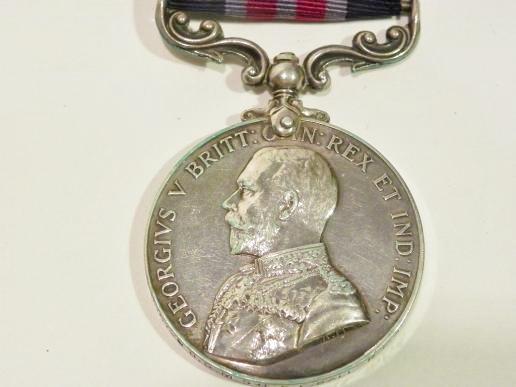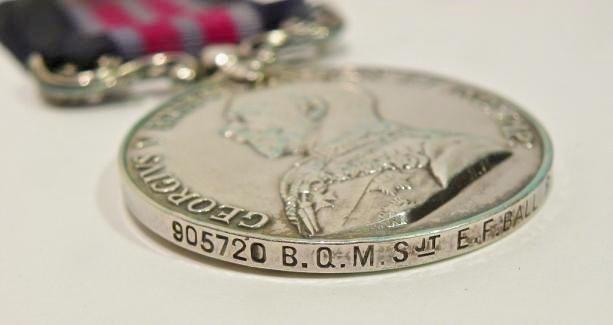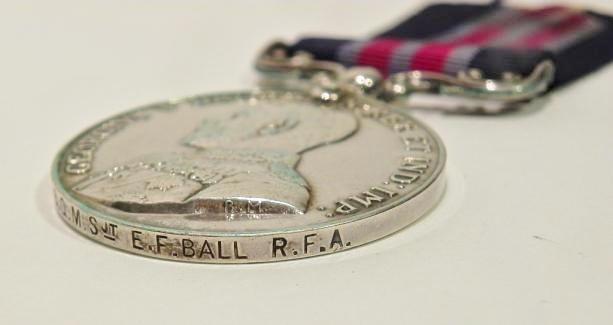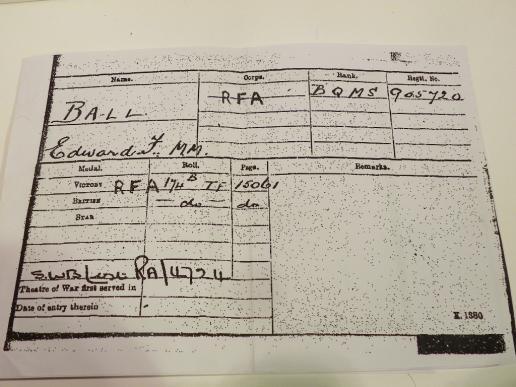Scarce WW1 MM to BQMS RFA for Mesopotamia.
A scarce and interesting WW1 Military Medal awarded for Bravery in the Field correctly named to 905720 Battalion Quarter Master Serjeant Edward Francis Ball of the 337th Brigade Royal field Artillery. One on only 366 MM’s awarded for the Mesopotamia campaign. Ball came from Bexhill-on-Sea and he enrolled into the 1st Cinque Ports Artillery Volunteers in the November of 1914 and formed part of the 337 Brigade. In the early part of the war it performed home counties defence duties before being sent to Mesopotamia in 1917 where it joined the newly formed 18th Indian Division at Baghdad by February 1918. At the beginning of March 1918 the division began moving up the Tigris to join I Indian Corps, and 337th Bde went to Samarra with 55th Indian Brigade. By October 1918 the Turks were in retreat in Palestine and on the Euphrates Front in Mesopotamia. Rather than make a direct assault with the untried 18th Indian Division, the British Corps commander, Lt-Gen Sir Alexander Cobbe, VC, chose to outflank the gorge with a mobile column. Covered by the 55th Indian Bde, 337th Bde moved into position during the night of 22/23 October and by morning was within a mile of the Fat-Ha trenches, registering guns on its targets. Advancing after dark, the infantry found the outflanked trenches abandoned, and 53rd Indian Brigade passed through the gorge, followed by 337th Bde, despite the appalling terrain for hauling guns.
The following day the division had reached Tell-ad-Dhahab, and cavalry patrols were across the Little Zab. Next day, 25 October, the advance continued, with 53rd Indian Bde and C/337 Bty reaching the Shumait Ford early in the morning, followed by the rest of the artillery. By noon the three field batteries of 337th Bde were in action, in the open in full view of the enemy but with magnificent observation posts on a nearby hill. 341 Battery reached the Tigris–Little Zab junction and came into action at close range, but was suddenly hit by accurate Turkish shellfire, losing all but two guns, most of its wagons and several men. However, its action allowed C/337 Bty to come into action a couple of miles away undisturbed and for more of the corps artillery to close up and support the infantry crossing. The following day 337th Bde was across the Little Zab and engaging enemy guns. Once again the position was outflanked by the mobile column, and early on 27 October patrols found the Turkish trenches empty. At dawn on 28 October the Battle of Sharqat opened, with the guns on the east bank firing across the river, A/337 Bty later crossing the Tigris by a ford and galloping up to join in. The following morning C/337 Bty also crossed to the west bank where an afternoon attack made good progress, A/337 Bty supporting a charge by the 13th Hussars. The force on the west bank was about to attack Sharqat on the morning of 30 October, when the Turks in the town surrendered. The commander of 18th Indian Division, Maj-Gen Hew Fanshawe, was immediately sent on with a mobile column including A/337 Bty to destroy the remaining Turkish forces and capture Mosul. The column forded the Tigris, with artillery horses assisting the mule carts, and pushed on to the city, which fell without a fight after news arrived of the signing of the Armistice of Mudros and the end of hostilities on 31 October. At the end of the war 18th Indian Division was selected to form part of the occupation force in Iraq but at some point after the armistice, BQMS Ball fell sick with one of the diseases rife in the country and he was discharged at the end of December 1919. Life was hard for all the soldiers in Mesopotamia, it was either burning hot or freezing cold on difficult terrain, adequate supplies were few and all manner of nasty diseases were the only thing in abundance. His MM was almost certainly awarded for the action along the Tigris, although a little more research with help to discover at what point, the battalion war diary would be of help. A more detailed account of this battle is included, along with a copy of his medal index card, medal roll, Military Medal index card and London Gazette entry for the 20th August 1919. The medal is in lovely original condition and looks as if it has never been mounted or worn.
A scarce gallantry award for a very under rated campaign.
Code: 25520
320.00 GBP







